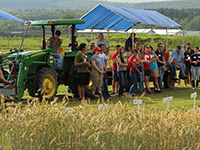 Skill Level
Skill Level
Intermediate, Advanced
Learner Outcomes
- Understand the inputs and outputs of our food system.
- Evaluate different influences on our food system and impacts of our food.
- Explore connections between different political, environmental, social, and health factors of our food system.
Life Skills
Critical thinking, learning to learn, communications, social skills, accepting differences, sharing, contribution to group, marketable/useful skills, teamwork, self-responsibility, character, managing feelings
Time
This activity can take place over multiple sessions. Timing can vary for each part. We suggest 20 minutes for food system videos, 20 minutes for food system inputs and outputs, and 20 minutes for Food System connections.
Materials
- Name that In/Output! game handout
- Food System Factor Cards
- Ball of yarn
Space
Any space allowing youth to have discussion and gather in a circle
Introduction
This activity begins to take a deeper look into the complexities of our food system. It is appropriate for groups who already have familiarity with food systems. There are inputs needed to drive the food system such as labor, materials, energy, water, chemicals, and capital. There are outputs coming out of our food system beyond food and food products, such as waste and air emissions. Many people agree that our current food system is not sustainable in how it currently functions. Research shows many participants in the food system are struggling. This introduction takes an enormously complex subject and attempts to break it down into a few pieces. As such, it may be most appropriate for older youth. As a facilitator, you can determine its appropriateness.
The influences of our current food system stretch beyond impacting what is on our plate. Each of its parts—growing, processing, distributing, accessing, eating, and disposing—is affected by and affects our environments, communities, and economies. Below is a streamlined introduction to these complexities. We encourage facilitators to reflect upon how this makes you feel, since this activity is an opportunity for you to model authenticity for the young people with whom you work.
Shaping the prices, safety, labeling, and advertising of food are a few of the ways in which government and businesses influence our food system. There are policies that affect food at each level of government—federal, state, and local. Some of the ways that government can influence our food system include laws, regulations, subsidies, taxes, and crop insurance programs. Government can encourage farmers to grow certain crops or manage their crops in certain ways. Through regulating food labels and advertising, government shapes the information people receive about their food. An example of this is labeling calories on fast food menus. In addition, the federal government releases national Dietary Guidelines every five years which serve as the foundation for federal food, nutrition, and health programs such as the National School Lunch Program and Supplemental Nutrition Assistance Program (SNAP, formerly known as food stamps).
Culture and society influence the food we eat, and the food system influences culture and society. The food we eat, and how we access and prepare it is connected who we are. Many social gatherings center around eating food together. Our diet and our health our intimately connected.
Each part of our food system feels the impact of climate change and also contributes to it. The changing rainfall patterns are causing more severe weather events, such as floods and droughts, across the world. Floods increase soil erosion, pollute water, and damage community infrastructure. Droughts are depleting our water supply and can contribute to wildfires. Changing temperature patterns have led to warmer temperatures and more extreme heat, which can cause challenging working conditions and affect what plants can be grown in particular areas. Changes in climate can also lead to new pest problems. All these factors can lead to crop loss, meaning less overall food production.
Contributing to climate change, each part of our food system requires energy and water to function. Typically, we rely on equipment and machines powered by fossil fuels. Food can travel thousands of miles before it gets to your plate. Burning fossil fuels releases carbon and other greenhouse gases into the atmosphere, contributing to climate change. Water has many uses in the food system; it is used to grow our food, clean our food, cool down our processing equipment, mist our produce in the grocery store, hydrate people working in the food system, cook our food, and clean recyclables in waste recovery centers. Neglectful water management can lead to depletion and pollution of water sources.
Taking a closer look at the large-scale conventional farming practices we use to grow our food, we see that they have damaged our soils and oftentimes, eliminated biodiversity in the agroecosystem. Leaving fields and their soil bare in the off season and regular, heavy tillage reduces the amount of nutrients in soil and degrades soil structure. This can lessen the ability of soil to hold water and make it more susceptible to erosion. To compensate for degraded soils, farmers apply fertilizers to add nutrients back to the soil. Producing and transporting fertilizers requires energy, and field run-off can result in fertilizers ending up in unwanted places such as our water supply. Typically, large scale conventional farmers grow one food crop in a field at a specific time, this is called a “monoculture.” This lack of diversity makes food crops vulnerable to pests and climate conditions.
In addition to the above effects, it is estimated that 30-40% of the food produced in the United States is wasted. Food waste has numerous causes including overproduction, spoilage, culling of blemished produce, and buying more than we need. Food waste is an unnecessary waste of money and resources, and that food could go to feeding the millions of people in the United States and around the world who are food insecure.
Above are just a handful of examples of how our current food system is impacted by and contributing to climate change. The good news is that for as much as it contributes, our food system can also play a large role in mitigation and adaptation to climate change. Our food system has not always been this way. We can reduce greenhouse gas emissions and make communities and farms more resilient to climate change. Climate smart farming practices are becoming more and more common. These include things such as crop rotation, no-till farming, planting cover crops, and intercropping build healthy soils and counter the need for fertilizers. Building back healthy soils health increases their ability to draw down carbon from the atmosphere and store it. By choosing to consume and promote sourcing of local food, we can reduce transportation impacts. We can waste less food through prevention, rescue, and recycling strategies. More and more programs are also beginning to look at climate suffering and adaptation, reflecting on the psychological consequences on human health.
These impacts and influences of the food system affect people differently. Harmful effects of the food system traditionally have been felt the hardest by low-income communities, indigenous communities, and communities of color.
This activity is meant to start discussion about the various inputs and outputs, influences and impacts of our food system and we invite you, as a facilitator, to consider what is most appropriate for your group, holding the tension between the harder realities of present-day issues and the readiness of your group members to discuss them. The following videos can provide framing to help facilitators and young people think about the bigger picture of the food system. We encourage facilitators to watch the videos first and determine which would be a good fit for your group.
- Follow that Food- Carrot Edition Minnesota Department of Agriculture
- Food Systems Approach by WUR explained in 1 minute Wageningen University & Research
- Home Flavored Real Food Media
- Why do we need to change our food system? UN Environment Programme
Vocabulary
Input: materials and resources that enter a system to make it function
Output: the products and byproducts that come out of a system
Climate: average weather in a specific region over a period of time
Before the Activity
- Determine which food system videos are a good fit for your group.
- Cut out Food System Factor Cards.
- Assess where your group is at with their knowledge of food systems. It can be helpful to review the parts of the food system discussed in 3.3 Journeying Through Our Food System before this activity.
Activity
Opening Questions
Choose questions suitable for the group, if appropriate pose the question to set the tone and do not seek an answer.
- What influences our food system?
- What impact does our food system have on our world?
- How could our food system impact our climate?
- How could climate influence our food system?
- How could our food system impact our health?
Experience
- As a group, watch one or a few of the following videos to investigate food system impacts on environment, community, and economy:
•Follow that Food- Carrot Edition Minnesota Department of Agriculture
•Food Systems Approach by WUR explained in 1 minute Wageningen University & Research
•Home Flavored Real Food Media
•Why do we need to change our food system? UN Environment Programme - After watching the videos make space for youth to process. Ask them to share a word to describe how they are feeling.
- Share with the group how the food system is complex. There are many influences acting on the food system as well as many impacts resulting from the food system. To begin thinking about these influences and impacts, let’s think about what needs to be put into the food system to make it function (inputs) and what products and byproducts come out of it (outputs). On a board or poster paper, make a T-chart with the headings “inputs” and “outputs.” Have youth brainstorm a list of inputs (materials and resources) that go into the food system and outputs (products and byproducts) that come out of the food system.
- Explore these food system inputs and outputs further with the group by playing Name that In/Output! In this game, the leader (can be facilitator or a group member) reads a description of a food system input or output and then the rest of the group responds with the name of the input or output. The group is given a list of options to choose from. It can be helpful to print this list out for each participant or have it displayed for all to see. You can have one person read all the descriptions to the group or pass out a description so each person in the group can read one.
•For example, the leader says “Name that input! This input is used for irrigation, pesticide and fertilizer application, crop cooling and frost control in growing food. The group responds with the correct answer ‘Water.’ - After playing “Name that In/Output!” ask the group how these inputs and outputs could affect our food system, environment, communities, and economies.
- Pass out a Food System Factor Card to each youth, inviting them to think about how this factor impacts or is impacted by our food system.
- Create a web of connections. Have youth gather in a circle and display their card to the group. Pass a ball of yarn to someone in the group, have that person share their card and thoughts. After sharing, the person will hold onto the yarn and toss the ball of yarn to someone else in the group who has a factor they feel connects to their factor. For example, “Chemicals- Fertilizers and Pesticides” is connected to “Energy” as it takes energy to create these chemicals and apply them to crops. Another example, “Research and Technology” is connected to “Plant Health” as research and technology can develop tools to keep plants healthy. Keep in mind that each factor can connect to multiple other factors!
Reflection Questions (choose one or a few that work best for your group)
- Do you have any questions? If so, what are they?
- What have you discovered that surprised you?
- How has your perspective of the food system changed after this activity?
Extensions
- Take a field trip to a place in the food system. This could be a farm, processing plant, farmer’s market, waste facility, etc.
- Invite a guest speaker who plays a role in the food system into a group meeting. This could be a farm worker, politician, university researcher, etc.
- To explore the connection between gardening and climate change further, check out the Cornell Garden-Based Learning curriculum Gardening in Our Warming World: Youth Grow!
- If young people feel overwhelmed with the challenges of our food system, please spend a generous 20 minutes encouraging them to name all the goodness that they possibly can – such as the caregivers and kind people who serve food in homes and various institutions; the passionate farmers who year after year and despite weather challenges, are dedicated to growing food; activists who hope for a positive future who show up repeatedly; teachers and other educators who are dedicated to learning; and so on. You may even want to point out the brain’s negativity bias, that is, a bias toward noticing and remembering what’s wrong, and point out the importance of remembering the good, and what is possible.
Learn More
- Agriculture and Climate Environmental Protection Agency
- Climate Change Affects U.S. Agriculture and Rural Communities U.S. Department of Agriculture
- Climate Change and Agriculture: A Perfect Storm in Farm Country Union of Concerned Scientists
- Climate change: How do we know? NASA
- Climate Smart Farming Cornell University
- Food and Farm Solutions Union of Concerned Scientists
- Food Insecurity in New York Feeding America
- Food First Backgrounder on Racism in the Food System
- Food Policy 101 Foodprint.org
- Food Waste FAQs U.S. Department of Agriculture
- Gardening in a Warming World Cornell Garden-Based Learning
- NYS 4-H Agriculture and Food Systems
- The New Face of Hunger National Geographic
- Understanding Food and Climate Change: An Interactive Guide Center for Ecoliteracy
Curricula and lesson plans
- Discovering Our Food System Cornell Garden-Based Learning
- Food! How Do We Ensure Good Nutrition for All? Smithsonian Science Education Center
- Food for the SOL Seeds of Solidarity Education Center
- Food Systems for Thought and Change National 4-H at Home Series
- Food Systems Thinker by Mingla Charoenmuang, Purdue University
- FoodSpan John Hopkins Center for a Livable Future
- The Food Project
- Climate Change Phenomena: Bananas in Our Breadbasket? National Agriculture in the Classroom
Videos
- Climate crisis solutions – Food and Agriculture UN Environment Programme
- Decolonizing Our Food System (2020) The Doctor’s Farmacy with Leah Penniman
- Future of Food – Feeding the World in a Sustainable Way | Chiara Cecchini | TEDxKlagenfurt (2019)
- How we can eat our landscapes Pam Warhurst TEDSalon (2012)
- Why do we waste perfectly good food in the U.S.? | AJ+ (2018)
Acknowledgements
The “Name that In/Output!” game in this activity has been adapted from Food Systems Thinker – Lesson 2.3. Impact of Food Systems by Mingla Charoenmuang.









